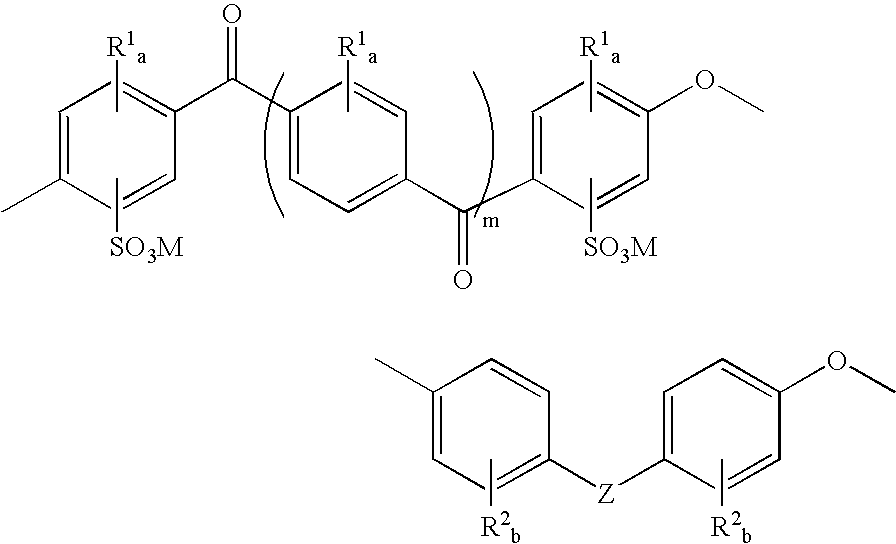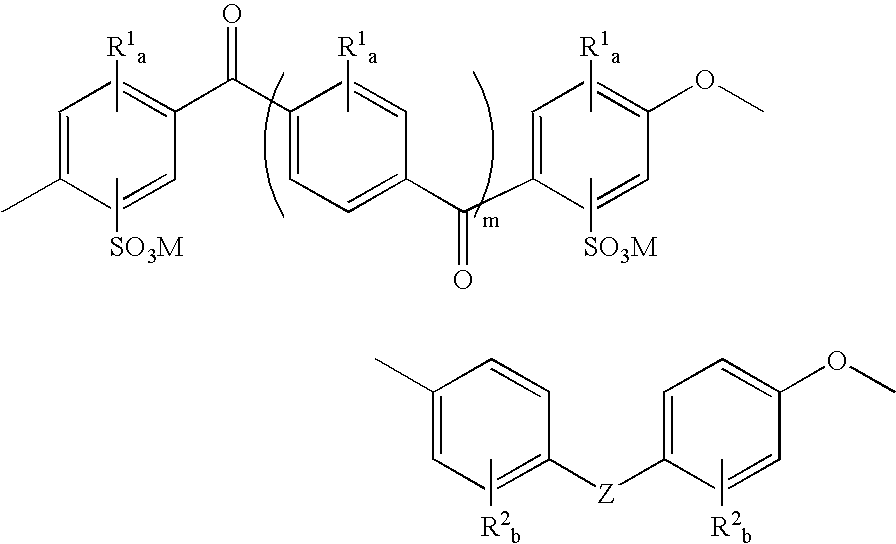Mixed-sulfonation block copolymers
a technology of polyaryletherketone and polyethersulfone, which is applied in the field of mixed sulfonation polyaryletherketonepolyethersulfone block copolymers, can solve the problems of poor performance at low relative humidities, limited use of these membranes, and high cost, and achieves the effect of high conductivity
- Summary
- Abstract
- Description
- Claims
- Application Information
AI Technical Summary
Benefits of technology
Problems solved by technology
Method used
Image
Examples
example 1
Synthesis of Sulfonated Polyetheretherketone-Sulfonated Polyethersulfone Block Copolymers
[0058] Monomers and potassium carbonate were dried and stored in a nitrogen purge box. Toluene was dried over activated molecular sieves. All other chemicals were used as received.
[0059] The length of the SPEEK block was adjusted by the stoichiometry of sulfonated difluorobenzophenone and 4,4′-biphenol. The total degree of sulfonation was adjusted by the ratio of SPEEK:SPES block length and also by the ratio of sulfonated:non-sulfonated sulfone monomers in the SPES block. Sulfonated difluorobenzophenone (1 g, 2.37 mmol), 4,4′-biphenol (0.529 g, 2.84 mmol), and K2CO3 (1.227 g, 8.88 mmol) were transferred into a three-neck flask connected to a Dean-Stark trap / condenser, nitrogen inlet, and mechanical stirrer. DMSO (4 mL) and toluene (3 mL) were added. The mixture was stirred at 145° C. for 1 hour. 4,4′-Difluorodiphenylsulfone (0.722 g, 2.84 mmol), sulfonated difluorodiphenylsulfone (0.326 g, 0.7...
example 2
Membrane Preparation
[0061] The polymers were cast onto a glass plate from 10 wt % solutions in DMSO using a doctor blade (20 mil). The films were dried at 50° C. for 3 hours and then under vacuum at 100 ° C. for 24 hours. Acidification of the films was achieved by soaking in 1M H2SO4 at room temperature for 24 hours, followed by soaking in deionized water for 6 hours.
example 3
Membrane Proton Conductivity Measurement
[0062] The proton conductivity of the polymer membranes was determined by 4-electrode impedance measurements at various temperatures and relative humidities. Measurements used a Parstat impedance analyzer with PowerSine software, using a signal amplitude that ranged from 5 to 50 mV and frequencies ranging from 2 Hz to 2 MHz. The sample dimensions varied between samples, with a typical sample being 1.5 cm×2.5 cm and having a thicknesses ranging from 20 to 100 μm. Typical membranes were 25-50 μm in thickness. The proton conductivities of the block copolymers at various temperatures and relative humidities are listed in Tables 2-4.
TABLE 2Comparison of conductivity of mixed-sulfonation SPEEK-SPESblock copolymers with SPEEK-PES block copolymersTemp.Conductivity (S / cm)(° C.)RH (%)JH112JH86*JH92*201000.07270.05930.099660500.00340.00150.009480250.00160.00060.001880500.00660.00300.010780750.02420.01990.0209801000.08650.10050.0675100500.00880.00320.0...
PUM
| Property | Measurement | Unit |
|---|---|---|
| Mw | aaaaa | aaaaa |
| Mw | aaaaa | aaaaa |
| molecular weights | aaaaa | aaaaa |
Abstract
Description
Claims
Application Information
 Login to View More
Login to View More - R&D
- Intellectual Property
- Life Sciences
- Materials
- Tech Scout
- Unparalleled Data Quality
- Higher Quality Content
- 60% Fewer Hallucinations
Browse by: Latest US Patents, China's latest patents, Technical Efficacy Thesaurus, Application Domain, Technology Topic, Popular Technical Reports.
© 2025 PatSnap. All rights reserved.Legal|Privacy policy|Modern Slavery Act Transparency Statement|Sitemap|About US| Contact US: help@patsnap.com



